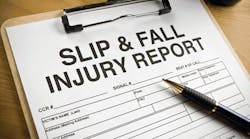Do your employees know what the next step is after one of them slips and falls on a grease spot and is injured? If you don't communicate the process for reporting injuries and filing workers' compensation claims with them, you most likely will be paying more than you should for your workers' compensation coverage.
While employers spend money on loss control efforts, incentive programs and safety programs, they often fail in one of the key areas to help control workers' compensation costs: managing the workers' compensation process. True, it is important to focus on injury prevention, but often that isn't enough. There are two more areas that employers need to give their attention to: managing the injury and managing the return-to-work process.
Injury reporting is a key factor in shaping the outcome of any employee injury. The sooner an injury is reported, the sooner a medical assessment can be made available and the sooner an employee is on the right track to recovery. It has been proven in several studies that lag time directly impacts the costs of claims. It is imperative that you stress to employees and supervisors that any employee injury must be reported immediately. This not only benefits the employer but the injured worker as well.
Injury Packet
Do your injured employees understand what will happen when they are injured? If you are not providing them with a pre-made injury packet then you already are falling behind in the process. This packet can help the employee understand the process, your expectations, and the return-to-work policies, and can help reduce any possible frustration with you, the doctor or the insurance company. It can help develop trust and show the employee that you care and that you are committed to quickly resolving work-related claims. There are other key components to the injury packet, but it is important to remember that outlining the expectations can help you lower claim costs.
When the injury is reported, what steps are you taking to ensure the injured worker can return to work as soon as possible? It is crucial that communication is set up between the injured worker, the doctor, the claims adjuster, supervisors and your agent to help ensure the injured worker can get back as soon as possible. If this isn't done correctly, it directly impacts the cost of the claim and your company's bottom line.
Something as simple as sending a card or making a phone call to an injured worker at home can help get him or her back to work sooner. It's not uncommon for injured employees to feel depressed and alone. Showing them that you are thinking about them can go a long way in accelerating the return-to-work progress and perhaps keep their mind off possible litigation.
Safety and risk management are important in preventing injuries, but are your supervisors trained in workers' compensation, to the point that they know and understand their role after an injury occurs? If your supervisors aren't trained in this area, it could hurt your company's profitability. Ensure they been trained in the following areas:
- The direct and indirect costs of past injuries and how they affect your experience modification factor.
- The minimum experience modification factor for your company. This can show how much money is involved with an inflated experience modification factor. The difference between your current experience mod and your minimum mod is called your controllable mod. The controllable mod will show how much money can be saved if claims can be reduced as well as indicate the potential dollar savings that can be utilized for special safety programs, equipment or other safety incentives. This information should be shared with your safety committee as well. Based on our experience, we find that less than 10 percent of companies are doing this now.
- The importance of having a claim remain "medical only" with no lost time. This is why prompt reporting of injuries is so crucial; many states are ERA (experience rating adjustment) states. This means that medical-only claims are reduced 70 percent when they are calculated for the experience modification factor. This is why return-to-work programs are so important and why it is imperative your supervisors play a key role in initiating a successful RTW program.
- Communication channels must be working along several fronts to keep workers' compensation costs low and return employees to work. This includes communication from top management to supervisors, supervisors to employees, employees to doctors, return-to-work coordinators to doctors, return-to-work coordinators to employees, return-to-work coordinators to claim adjusters and so on.
Very often, companies do a great job with preventing injuries but then incur costs they could have avoided because they simply have overlooked the injury management aspect. We have seen many examples where companies have increased their profitability just by improving their injury management programs, particularly supervisory training.
Carl Zeutzius is a certified work comp advisor (CWCA) and director of sales and marketing for UNICO Group, an independent insurance, risk management and financial services group based in Lincoln, Neb. He has over 20 years experience in the insurance industry. He can be reached at [email protected] or 402-434-7200.
